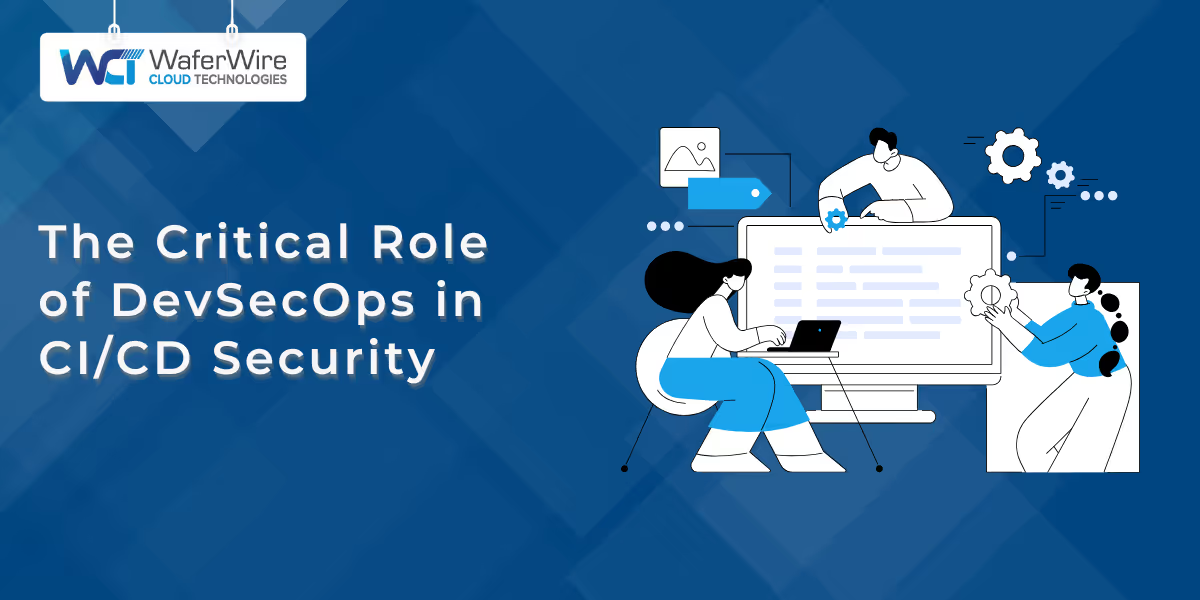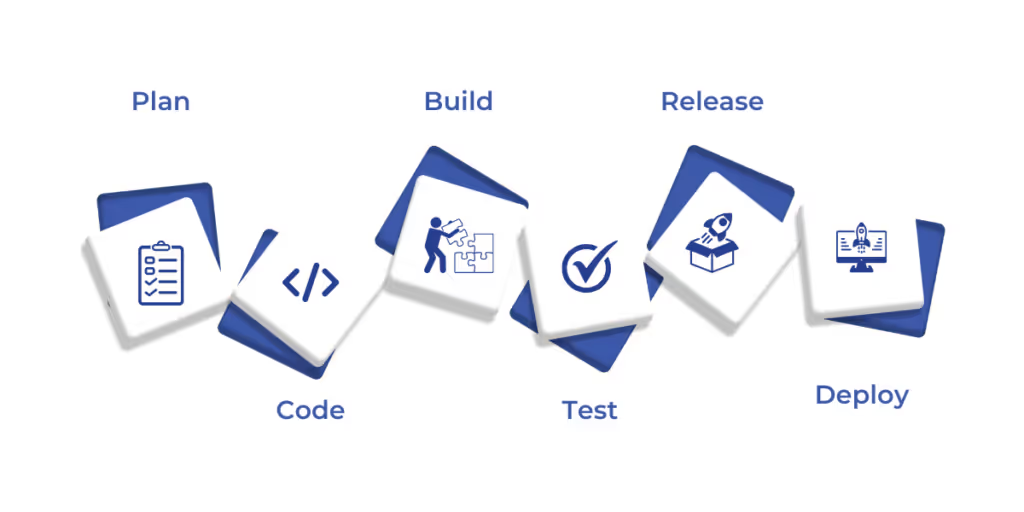

Security can’t be an afterthought in modern software delivery. DevSecOps CI/CD integrates security seamlessly into development and deployment, ensuring vulnerabilities are caught early and automatically (not at the last minute).
By embedding security checks into every code commit, build, and deployment, DevSecOps eliminates bottlenecks, enhances compliance, and prevents threats before they escalate. It transforms security from a standalone process into an automated, collaborative, and scalable part of CI/CD pipelines.
This article reveals how security into CI/CD through DevSecOps strengthens protection while keeping development fast and agile.
Security can’t be a last-minute fix—it must be built into the software development process. DevSecOps in CI/CD security ensures that security is embedded from the start, reducing risks without slowing down deployment.
DevSecOps combines development, security, and operations into a continuous workflow. Instead of treating security as a separate step, it integrates protective measures into every phase of the software development lifecycle (SDLC). This means security checks happen alongside coding, testing, and deployment.
In traditional development, security testing occurs at the end of the process, often leading to delays, missed vulnerabilities, and costly fixes. With DevSecOps, security becomes proactive, ensuring issues are caught early before they reach production.
In CI/CD, code is constantly being built, tested, and deployed. Without DevSecOps, security gaps can be exploited before teams even notice them. Embedding security early prevents breaches, ensures compliance, and keeps deployments smooth.
Now that we understand why DevSecOps in CI/CD security is essential, let's break down the key components of a secure DevSecOps pipeline.

Security isn’t a separate process—it’s a built-in layer across development. With DevSecOps embedded in CI/CD pipelines, security becomes a constant presence at every stage, identifying and addressing vulnerabilities before they escalate. Here’s how it works:
Now that security is embedded in each stage, let’s explore how to integrate these security measures seamlessly into CI/CD pipelines.
Every deployment carries risk, and a single unpatched vulnerability in an open-source component can expose an entire system.
Nearly 80% of modern applications use open-source components, but many come with undisclosed security risks. If left unchecked, a vulnerable third-party library could introduce security gaps.
Security must be integrated into every code commit and deployment cycle. If vulnerabilities are discovered after release, fixing them can cost up to 100 times more than if they were identified during development.
Security doesn’t stop at deployment. Continuous monitoring detects misconfigurations, unauthorized access, and API abuse in real time.
Even with strong security measures, challenges remain. Let’s examine common CI/CD security risks and how to solve them.

Security gaps in CI/CD pipelines expose businesses to data breaches, compliance violations, and operational disruptions. Many attacks stem from poor security hygiene, such as exposed credentials, unpatched dependencies, and misconfigured infrastructure. DevSecOps mitigates these risks by embedding security directly into development and deployment cycles.
Hardcoded secrets, exposed API keys, and misconfigured access controls are among the leading causes of security breaches. Attackers scan public and private repositories for embedded credentials, which can provide unauthorized access to databases, cloud services, and internal systems.
If security issues are discovered late in the software lifecycle, they can become expensive and difficult to fix. Unpatched open-source dependencies, unvalidated inputs, and insecure configurations can create serious security flaws.
Security isn’t just about scanning for risks—it must be actively enforced at every stage of development. Without CI/CD-level security controls, developers might bypass security best practices to speed up releases, increasing the risk of vulnerabilities slipping into production.
Next, we’ll explore essential tools for implementing DevSecOps and how they improve security without disrupting development workflows.
Security can become a bottleneck without the right technologies, delaying deployments and exposing businesses to risks.
Manual security checks can’t keep up with fast development cycles. Automated security testing ensures vulnerabilities are caught before deployment.
Outcome: Automated security testing reduces human error, speeds up risk detection, and ensures code security before production.
Modern deployments rely on containers and infrastructure automation, but misconfigurations introduce security gaps.
Outcome: Securing containers and infrastructure code ensures consistent, hardened environments, reducing security risks at scale.
Security isn’t solely about identifying vulnerabilities; it’s also about upholding security standards automatically.
Outcome: Security automation reduces compliance risks, prevents policy violations, and strengthens incident response.
The right tools lay the foundation for a secure CI/CD pipeline, but best practices drive real results. Next, we’ll explore proven strategies to enhance CI/CD security with DevSecOps.
While automation plays a crucial role, success lies in how teams work together, how security is enforced, and how issues are detected before they escalate.
One of the biggest mistakes in traditional security models is treating security as an isolated process. Developers push code, security teams audit it, and operations deploy it which often leading to conflicts, delays, and last-minute vulnerability fixes. This outdated approach doesn’t work in fast-moving CI/CD pipelines.
A successful DevSecOps CI/CD strategy demands collaboration from the start. Developers must understand secure coding practices. Security teams need to move beyond gatekeeping and work alongside developers to integrate security tools without slowing down innovation. Leadership must drive this shift, ensuring that security is a priority, not an afterthought.
Speed and security are often seen as competing forces in CI/CD. But security doesn’t have to slow down releases—it can accelerate them when done right.
By embedding security into the CI/CD workflow, businesses can ship faster with confidence, knowing that every release is secure by design.
Threats don’t stop when an application goes live. Security must be ongoing, not a one-time checklist before deployment.
Real-time security monitoring ensures that teams are alerted immediately if an API is misconfigured, a vulnerability is exploited, or an unauthorized login attempt occurs. SIEM tools, security analytics, and threat detection platforms provide real-time insights that allow teams to react before damage is done.
For organizations handling sensitive data, regulatory compliance isn’t just a checkbox; it’s mandatory. Continuous security validation ensures that every release meets compliance requirements, protecting both customers and the business from breaches and legal consequences.
Fast releases mean nothing if security is compromised. A single vulnerability can wipe out trust, disrupt operations, and cost millions. However, security is more than just preventing breaches; it is also about instilling trust in each deployment. When security is baked into development, teams move faster, compliance becomes effortless, and risks shrink before they become problems.
Yet, implementing DevSecOps isn’t just about plugging in tools. It’s about changing how teams think, work, and collaborate. Security can’t be a last-minute checklist, it has to be part of the code, the pipeline, and the culture.
That’s where WaferWire comes in. We don’t just help businesses add security to their CI/CD pipelines; we make it a seamless part of the development process. Whether you’re in finance, retail, manufacturing, or utilities, we help you build, deploy, and scale securely without slowing down innovation. Talk to our expert today and take control of your security.

